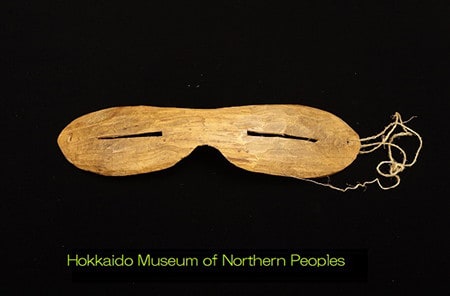


人間の刷り込まれた「固定観念」というのは怖ろしいなぁと深く反省の一件。
写真の「遮光器土偶」は日本史のなかでもとりわけ有名な一品。たとえてみれば本能寺の変とも並び立つほどの、信長級の超ポピュラー大スターだと言えるでしょう。
わたしがこの土偶の画像とめぐり会ったのはたぶん小学校低学年の時期だろうと思います。「これはシャコウキドグウと言って、縄文時代の遺跡から発見されました」みたいに教科書で習ったのだろうと思います。
子どもこころに圧倒的なその視認印象が強烈で「これはどうみても地球に降り立った宇宙人に間違いない」と深くこころに沈殿した。
肝心の「遮光器」についての詳細な説明はその当時なかったのではないかと記憶している。いや、先生は補足説明したのかも知れないが、あまりに異星人的な印象が強烈で、そのまま刷り込まれてしまって、それは先史時代への強烈な探究動機ゾーンに仕舞い込まれてしまったのかも知れない。
恥ずかしながら、先日はじめて「遮光器」という実物と対面して説明を聞いてしまった。
現代でも北方民族のみなさんは冬の雪原からの反射光への基本対策として強烈なその乱反射から目を守るのに「遮光」する木製メガネを使っているという説明。
「おお」であります。
少年期に刷り込まれた「印象の固定化・誤謬」からついに解放されてしまった(笑)。
北海道の冬の雪原での視覚体験はたっぷりと積層しているし、その反射光から目を守るのにゴーグルをする人がいることも知っているのに、まったく不意を突かれてしまった。
下の写真は北海道立北方民族博物館資料目録3の木製雪眼鏡。使用民族はエスキモーで米国/アラスカ 1890-1930年 8.5㎝という説明文が付けられている。
「極北の長い冬がおわり、陽射しが高くなるにつれて、雪原の照り返しが強くなる。このような季節には、紫外線から目を保護する必要がある。狩猟や旅行では長い時間、雪原や氷上で行動するため、エスキモーは木や骨などを利用してこのようなスリット状の穴を開けた雪眼鏡を作り目を守ってきた。日本の遮光器土偶の名称に使われた遮光器がこの雪眼鏡のことである。」と明記されている。
幼少年期からの呪縛・凝り固まった「宇宙人」イメージがようやく破砕された。なんもさ、であります。そうならそうと早く言ってくれよ、というところですが、やはり初見の人間の印象というのは重いのだとも気付かされる。また、この宇宙人イメージがあったことで無上の吸引力で歴史への興味が喚起され続けたとも言える。
ただ、その後の日本人はこういう遮光器を民具としてもほぼ伝承していない。
縄文の時期はむしろ現代よりも温暖だった時期の方が長いともされている。
信長の本能寺は徐々に解明されつつあるけれど、遮光器土偶の解明はやはりなかなか進展しませんね。むしろ興味の吸引装置としてはこのような状態の方が望ましいとも思える。
English version⬇
[First time in my life I confirmed the "light shielding device" of the light shielding clay figurine (sweat).
First encounter with the wooden light-shielding glasses inherited by modern northern peoples. Is this the clarification of the truth similar to the true culprit of the Honnoji Incident? ...
This is a case that makes me deeply reflect on the fearful nature of the "stereotypes" that are imprinted on human beings.
The "Shakogu Dogu" in the photo is one of the most famous items in Japanese history. It is a very popular star of Nobunaga's level, comparable to the Honnoji Incident.
I think I first came across the image of this clay figurine when I was in the early grades of elementary school. I think I learned from my textbooks that "this is a Shakokidogu, which was found at a Jomon-era site.
The overwhelming visual impression of the object made a deep impression on me as a child, and I was deeply moved by the thought, "This is definitely an alien that has landed on the earth.
I remember that there was no detailed explanation of the "light shielding device," which was the most important part of the telescope, at that time. Perhaps the professor may have given a supplementary explanation, but the impression was so strong and alien that it was imprinted on my mind, and it may have been stored in the zone of my strong motivation to explore prehistoric times.
I am ashamed to admit that the other day I came face to face with an actual "light-shielding device" for the first time and listened to its explanation.
He explained that even today, northern peoples use wooden glasses to protect their eyes from the intense diffuse reflections of reflected light from snow fields in winter as a basic measure.
Oh," he said.
I was finally freed from the "fixed and erroneous impressions" imprinted on me as a boy (laugh).
Although I have plenty of laminated visual experiences in the winter snow fields of Hokkaido and know that some people wear goggles to protect their eyes from the reflected light, I was caught completely off guard.
The photo below shows wooden snow goggles from the Hokkaido Museum of Northern Peoples' Materials Catalog 3. The description of the glasses reads, "The people who used them were Eskimos from the United States/Alaska, 1890-1930, 8.5 cm.
The long winter in the Arctic is over, and as the sun shines higher in the sky, the snowfield becomes more reflective. During these seasons, it is necessary to protect the eyes from ultraviolet rays. Because of the long hours they spend hunting and traveling on snowfields and ice, Eskimos made snow goggles with slit holes in them out of wood or bone to protect their eyes. The snow goggles are the light shields used to name the Japanese light shielding clay figurines. The article clearly states, "The snow goggles were used to protect the eyes.
The "alien" image that had been spellbound and hardened since my childhood was finally shattered. I am not an "alien" at all. If that's the case, you should have said so earlier, but it also made me realize that the impression of a person who sees something for the first time is a heavy one. It can also be said that the presence of this alien image has continued to arouse interest in history with unparalleled power of attraction.
However, Japanese people did not inherit this kind of shading device as a folk tool until later.
It is also said that the Jomon period was rather longer than the present day, when the climate was warmer.
Although Nobunaga's Honnoji is gradually being elucidated, the elucidation of the light-shielding clay figurines is still not progressing very well. In fact, it seems that this state of affairs is more desirable as a device for attracting interest.



















